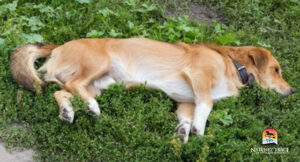Seeing your pup have a seizure is among the most terrifying experiences you can imagine. No matter how scared you feel, be assured there are ways to manage dog seizures.
Read on to learn more about causes, symptoms, and what to do when your dog has one.
What Causes Seizures in Dogs?
Similar to idiopathic head tremors, canine seizures frequently have no known cause. However, there are variables found to be linked with the condition:
- Genetic disorder

- Ingestion of some toxin
- Brain trauma
- Kidney or liver disease
- Brain tumor
- Cancer
- Blood abnormalities (i.e. low blood sugar)
- Severe anemia
Types of Canine Seizures
Vets emphasize the need to make the correct diagnosis for your pet’s overall care and health, given that there are several types of seizures that dogs can experience such as:
- Generalized seizure or grand mal seizure. These are the most typical seizure forms in canines. All areas of the brain are disturbed. Convulsions that cause a dog to lose consciousness might last anywhere from a few seconds and a few minutes.
 Focal or partial seizures. Only one area of the dog’s body is affected when this kind of seizure happens in just one portion of the brain. Although they only last a few seconds, they can develop into generalized seizures.
Focal or partial seizures. Only one area of the dog’s body is affected when this kind of seizure happens in just one portion of the brain. Although they only last a few seconds, they can develop into generalized seizures.- Psychomotor seizure. This kind of seizure in dogs only lasts a few minutes and is characterized by odd behavior. Dogs who have this kind of seizure will abruptly attack their tails or other hidden objects.
- Idiopathic epilepsy. When a seizure cannot be classified, it’s considered an idiopathic seizure.
These circumstances might leave you feeling inadequate and out of control. Yet, there are things you can do to manage dog seizures.
4 Things to Do to Manage Dog Seizures
You can manage dog seizures and help your dog recover safely by doing the following:
1. Buy Herbal Formulas That Settle Seizures
Buy herbal calming formulations to minimize the impact of anxious conditions. Traditional Chinese Veterinary Medicine views seizures as a severe form of internal wind. An ancient herbal mixture called Herbsmith Gastrodia Settle Seizures is used to expel internal wind and manage dog seizures.
2. Keto Diet and Medium Chain Triglycerides (MCT)
 Feed your dog a healthy keto diet which is more easily oxidized by the brain. Emerging studies show that Medium Chain Triglycerides (MCT) reduce seizure frequency in dogs, making it a viable option to manage dog seizures. This is because they provide an alternative energy supply to the brain.
Feed your dog a healthy keto diet which is more easily oxidized by the brain. Emerging studies show that Medium Chain Triglycerides (MCT) reduce seizure frequency in dogs, making it a viable option to manage dog seizures. This is because they provide an alternative energy supply to the brain.
3. Reduce stress-inducing factors
 The most common reason for seizures in humans is simply stress. The same is true for your dog. You should constantly help your dog to avoid stress, just as you would for yourself. Given that stress is known to “trigger” seizures, lowering stress levels and minimizing environmental changes for your dog can help.
The most common reason for seizures in humans is simply stress. The same is true for your dog. You should constantly help your dog to avoid stress, just as you would for yourself. Given that stress is known to “trigger” seizures, lowering stress levels and minimizing environmental changes for your dog can help.
4. Schedule exams with Dr. Smith twice per year
 Getting your pet checked twice a year by your vet will also come in handy. A complete physical examination could reveal information regarding what might be causing a potential seizure.
Getting your pet checked twice a year by your vet will also come in handy. A complete physical examination could reveal information regarding what might be causing a potential seizure.
Screening tests to search for metabolic disorders and other conditions that might cause seizures will probably be advised. Contact our holistic vet now.
The above steps are only for management. Now you may be wondering what you can do to help your frightened furry friend the moment a seizure occurs.
What to Do When Your Dog Seizes
You can manage dog seizures. However, seizures can happen in the most random of times. So, what can you do when it does happen?
Following these steps will help keep you and your dog safe until the seizure is over:
- Stay composed. Although it could be challenging, your dog’s well-being depends on your ability to focus. Steer clear from anxious thoughts and focus on the work.
- Verify the time. Your veterinarian will need to know the time it began and how long it lasted in order to give a proper diagnosis.
- Protect your dogs from harming themselves. Cushion their head, keep them away from stairs, and console them until they begin to regain awareness.
 Apply cold water or damp towels to certain areas. Doing so on the groin, neck, paws, and head will help them cool off. Dogs may be at risk for overheating if their seizures persist longer than two to three minutes.
Apply cold water or damp towels to certain areas. Doing so on the groin, neck, paws, and head will help them cool off. Dogs may be at risk for overheating if their seizures persist longer than two to three minutes.- Call your regular veterinarian. Even if your dog seems to be acting normally thereafter contact your vet or an emergency vet.
- Keep track of your dog’s seizures. Track the date, time, and duration of each one. Start a journal or write a note on your phone. This can help your vet ascertain if there is a pattern to your dog’s seizures.
In addition to these steps, you may go for another convenient way to manage dog seizures.
The Eastern Medicine Philosophy to Managing Dog Seizures
A seizure is an abrupt uncontrolled electrical disturbance in the brain. The main component of Herbsmith Gastrodia Settle Seizures, gastrodia, has been shown to increase the threshold at which neurons activate, according to scientific studies.
 This formula reduces the brain’s neurons randomly firing out of control by lowering the firing threshold, which results in fewer and less severe seizures.
This formula reduces the brain’s neurons randomly firing out of control by lowering the firing threshold, which results in fewer and less severe seizures.
The animal body is comparable to nature in Chinese medical philosophy. Seizures (the most severe type of excessive wind) are referred to as “inside tornadoes”.
Excessive wind is also known as liver yang moving upward. Herbsmith Gastrodia Settle Seizures contains herbs that quiet the liver yang, put out the wind, and thus manage dog seizures.
Conclusion
All dog breeds can suffer from seizures at some point in their lives.
If there comes a time when your dog experiences a seizure, you’ll be prepared to help him through it every step of the way when you keep the above tips in mind.







